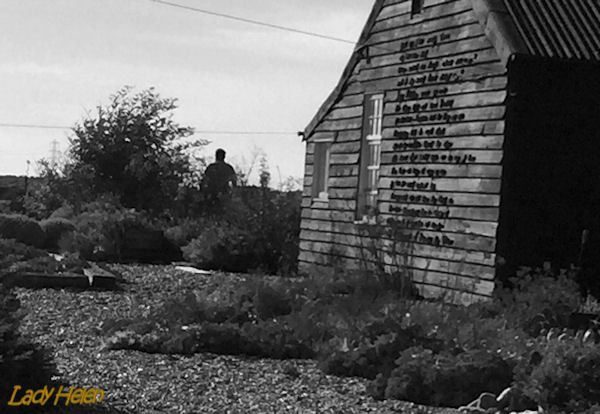
The UK’s only official desert is dotted with shipping containers and paraphenalia discarded by the crab fishermen who call these stony wastes their home and their mistress. Black shacks crouch amongst the crabpots and occasionally a lurking figure might be seen.
Dark and forbidding, Lady Helen stalked the shingle of Dungeness. It felt like a scene that had been cut from “Deliverance”. With banjos playing in my head, I followed her across the treacherous wastes, glancing behind me at the brooding menace of the de-commisioned nuclear power station. A steam whistle from the incongruous miniature railway squealed in the distance.
Most people avoid the shingles of Dunge and those that do come, seldom venture as far as the ness. I would not have gone, but for the comforting presence of Lady Helen, her broad shoulders providing a welcome break from the driving wind. One stern look was enough to scour the bowels and send any potential ne’er-do-wells scuttling back to their hovels.

I wanted somewhere dramatic to celebrate my 2000th eBird submission. In the same week that I lost my big lens, Lady Helen discovered phone filters and announced that she was “orf to the ‘ness” for some atmospheric pictures. One of the UK’s most celebrated birding hotspots, Dungeness is a bleak, windswept headland in south Kent, looking out across the English Channel.
The Lady Gannet wanted to capture the hostile feel, the hopelessness and despair of this wretched place. “Isn’t this wonderful”, she enthused, as she snapped merrily away. Sadly we have no pictures of birds, but they were there. Our first spot turned out to be a UK first for me in the form of a Great Egret. Northern Wheatears were teed up on dried scrub and a never ending procession of gulls passed overhead. Out on The Channel, Northern Gannets and Sandwich Terns dived for fish.
Dungeness is perfectly positioned on the English coast to catch migrants from the continent and Africa as they stream north in the spring and then return through September, October and November. There is an impressive autumn passage of seabirds featuring skuas and terns. The site is slightly spread out and boasts 2 hotspots in the UK’s top 10.
The links for the bird-ringing station (which has recorded 299 species) and the RSPB visitors’ centre, give a much sunnier account of Dunge. They even include pictures of birds in their posts, but maybe they had taken better care of their cameras.
















Leave a Comment